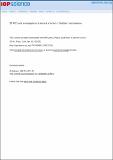3D PiC code investigations of Auroral Kilometric Radiation mechanisms
Abstract
Efficient (similar to 1%) electron cyclotron radio emissions are known to originate in the X mode from regions of locally depleted plasma in the Earths polar magnetosphere. These emissions are commonly referred to as the Auroral Kilometric Radiation (AKR). AKR occurs naturally in these polar regions where electrons are accelerated by electric fields into the increasing planetary magnetic dipole. Here conservation of the magnetic moment converts axial to rotational momentum forming a horseshoe distribution in velocity phase space. This distribution is unstable to cyclotron emission with radiation emitted in the X-mode. Initial studies were conducted in the form of 2D PiC code simulations [1] and a scaled laboratory experiment that was constructed to reproduce the mechanism of AKR. As studies progressed, 3D PiC code simulations were conducted to enable complete investigation of the complex interaction dimensions. A maximum efficiency of 1.25% is predicted from these simulations in the same mode and frequency as measured in the experiment. This is also consistent with geophysical observations and the predictions of theory.
Citation
Gillespie , K M , McConville , S L , Speirs , D C , Ronald , K , Phelps , A D R , Bingham , R , Cross , A W , Robertson , C W , Whyte , C G , He , W , Vorgul , I , Cairns , R A & Kellett , B J 2014 , 3D PiC code investigations of Auroral Kilometric Radiation mechanisms . in 15th International Congress on Plasma Physics (ICPP2010) & 13th Latin American Workshop on Plasma Physics (LAWPP2010) . Journal of Physics Conference Series , vol. 511 , IOP Publishing Ltd. , Bristol , 15th International Congress on Plasma Physics (ICPP) / 13th Latin American Workshop on Plasma Physics (LAWPP) , Chile , 8/08/10 . https://doi.org/10.1088/1742-6596/511/1/012051 conference
Publication
15th International Congress on Plasma Physics (ICPP2010) & 13th Latin American Workshop on Plasma Physics (LAWPP2010)
ISSN
1742-6588Type
Conference item
Collections
Items in the St Andrews Research Repository are protected by copyright, with all rights reserved, unless otherwise indicated.

